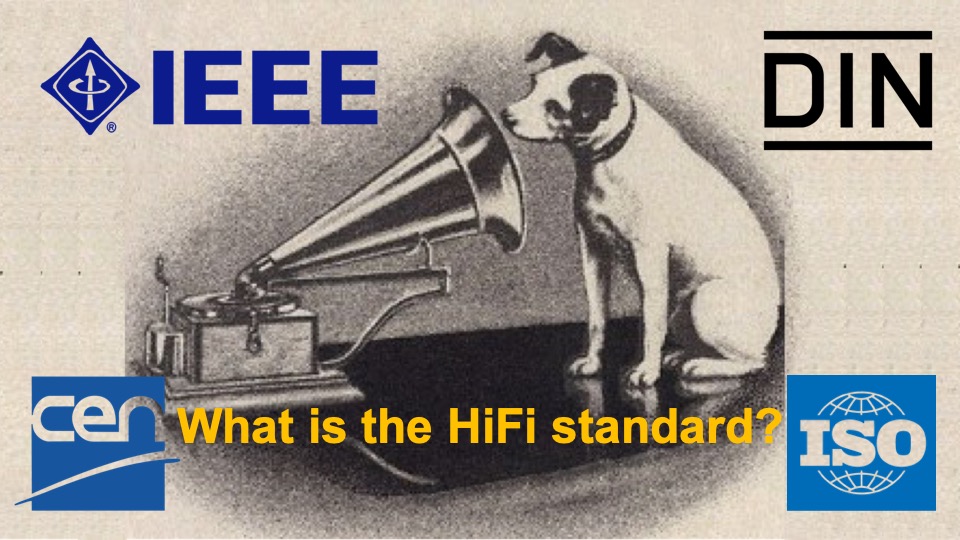
HiFi – what exactly does it mean? High Fidelity definition, DIN, EN, ISO, IEEE?
What is the HiFi standard?
Nowadays, if we want to know something, we look into Wikipedia and here we get:
High fidelity (often shortened to hi-fi or hifi) is a term used by listeners, audiophiles and home audio enthusiasts to refer to high-quality reproduction of sound. This is in contrast to the lower quality sound produced by worse audio equipment, or the inferior quality of sound reproduction that can be heard in recordings made until the late 1940s. Ideally, high-fidelity equipment has inaudible noise and distortion, and a flat (neutral, uncolored) frequency response within the human hearing range.
So, that is HiFi, no noise, no distortion and a neutral, uncolored frequency response.
What does distortion sound like? Would my system have some? What does uncolored frequency response mean? How could I hear that, or who would honestly tell me that the system I am listening to has it? Are there labels on audio systems who inform about their HiFi quality, for example that their coloration and distortion are below a typical value? Are audio systems certified against a certain standard a user could trust in?
Consumers usually trust standards. The Germans are so correct, they for sure have a standard for about everything. The EU even has a regulation 2257/94 on bananas, they must have something for HiFi as well.
What about the norms or standards?
German standard for HiFi is DIN45500 and the EU norm for HiFi is EN61305. There might be some more, like the IEEE or others, all being of no realistic help for non-technicians who don’t have detailed, specific knowledge and access to measurement systems. This gets a bit complicated as the DIN was replaced by the EN and the EN61305 is not in use anymore, it became kind of irrelevant nowadays. Thus this leaves us with no standard, respectively no available label for HiFi on consumer audio systems.
However, wiki is not wrong. DIN, EN, IEEE and other include frequency range, output power, distortions, signal to noise ratio and several other criteria. While some standards still set thresholds for their criteria to be reached, the EN only describes the measurement procedures for such criteria. All in all, there is currently no standard in use that is commonly accepted and defines technically HiFi.
For TV’s we have it, for HiFi we don’t.
That is really a pity. When we buy a TV there are some defined and commonly accepted standard criteria to help us identify the better from the worse. TVs have stickers like “full HD” or “4K” and others. These describe the TV screen capabilities, but do not indicate anything about the quality of the source – the movie we watch on it.
It is a common misunderstanding around HiFi. Labels on audio systems like FLAC, high res. or vinyl disc do not tell you anything about the sound quality of the audio system but only about the quality of the source – the recorded music.
That means that FLAC or vinyl do not tell much about the listening quality. The music source is an element within the sound chain. The source is only one of many influences on the complete playback quality of the audio system. Beginning at the recording of the music, the sound chain continues with the storage and playback, the amplification and finally with the reproduction of the sound by the speakers. The air carries the sound. The ambience or room compromise the sound bevor it reaches our ears.
TestHiFi a new approach.
Now there is TestHiFi. TestHiFi measures several common criteria like frequency range drops, peaks and stereo capability. In addition, TestHiFi also measures more complex criteria like harmonic distortions, high and low frequency intermodulation distortions and aurally weighted intermodulation distortion. TestHiFi applies certain thresholds to identify such drops, peaks or distortions. Tests of an audio system provide a final rating to declare if this system is far away (red), close to (amber) or potentially HiFi (green). It is simple in its application. Everybody with an iPhone can use it.
TestHiFi is just what the audio industry does anyway.
We wanted to have a HiFi standard, so simple that anyone can use it to check an audio system. Of course, it also had to be totally independent from any brand or advertising.
This is TestHiFi! The tests provide instantly reliable results – no need for looking, reading and trying to understand long reviews in specialized magazines. It is simple in use and structured to fit needs of different users. From simple overall ratings, to individual criteria ratings for users that would like to understand the result or detailed measurement data for the more technically affine people and audiophiles.
TestHiFi checks a variety of criteria after sending, recording and analyzing at the same time, a special test signal. For this we use the iPhone or iPad, utilizing Apple’s sophisticated technology. This technology is more than capable to help identifying the boarder between HiFi and non-HiFi.
TestHiFi is fully independent from brands or advertising. All test criteria of TestHiFi are based on standards commonly accepted in the audio industry. Those criteria are applied by the “older” standards and are the foundation of today’s professional sound measurements even in best audio studios.
TestHiFi can become an accepted HiFi standard.
Now imagine, there is a TestHiFi rating system available for everybody, differentiating bad systems from potentially good systems. Imagine further, it would be an app available for everybody. This app, TestHiFi, simply rates HiFi capability red, amber or green. This could be a new HiFi standard. Ratings of TestHiFi could become widely known and accepted like a “full HD” sticker on TVs.
TestHiFi – the new HiFi standard red/amber/green!